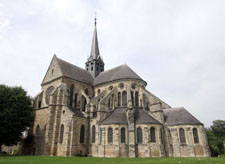Orbais-l'Abbaye (Marne, France) - Saints-Pierre-et-Paul
- Disclaimer
The dating found here is based on the work of John James, and is meant on this site to serve as a starting point. James' dating is derived from a system that uses his interpretation of the development of capitals over time as the basis for chronology, among other factors. His goal is to refine the dating to within years rather than decades. I have not fully embraced James' methodology, and will be developing this page from its current state to one which is admittedly more conservative. The relative expenditure values found in the Timeline are also based on James' work, and I believe these to be reasonably reliable. They are intended only to give a sense of the amount of work involved in each decade.
I have added the idea of the "project" as a way of separating work in buildings. In my mind, a "project" is a discrete section of work in a building that resulted from the one-time acquisition of funding. "Projects" are generally separated by at least a decade where no work was being done. It is my view that it would have been unwise to start a "project" that could not be finished and protected from the elements, and as such a "project" usually involved a wing or multiple wings of a building, from floor to roof. Rural churches, which could only secure small amounts of funding at irregular intervals, often were the result of many small projects, while the great churches, which benefitted from relatively consistent funding, may have involved only a few large projects.
I have added the idea of the "project" as a way of separating work in buildings. In my mind, a "project" is a discrete section of work in a building that resulted from the one-time acquisition of funding. "Projects" are generally separated by at least a decade where no work was being done. It is my view that it would have been unwise to start a "project" that could not be finished and protected from the elements, and as such a "project" usually involved a wing or multiple wings of a building, from floor to roof. Rural churches, which could only secure small amounts of funding at irregular intervals, often were the result of many small projects, while the great churches, which benefitted from relatively consistent funding, may have involved only a few large projects.
- Timeline with Relative Expenditure (if available, in building units)
 |
 |
 |
 |
 |
- Project A - Earlier - Phase 1 -
Church probably occupying the space within the piers.
- Project B - 1150s - Phase 2 - choir (d)
Choir ambulatory chapel walls with dado arcade as an Add-a-Chapel scheme around the earlier apse.
- Project B - 1150s - Phase 3 - choir (a)
Choir chapels capitals and vaults, with barrel vault to entry to axial chapel; work paused here for 17 years.
- Project C - 1180s - Phase 4 - choir piers
Choir drum piers and crossing with aisle vaults and transepts with the start of the nave walls.
- Project C - 1190s - Phase 5 - choir (t)
Choir triforium and east walls of transepts
- Project C - 1190s - Phase 6 - nave (a)
Nave piers and aisle vaults.
- Project C - 1200s - Phase 7 - choir (c)
Choir clerestory, high vaults and flyers.
- Project C - 1200s - Phase 8 - nave (t)
Nave triforium and start of clerestory while the transept walls were raised to their vaults and rose windows.
- Project C - 1210s - Phase 9 - nave (c,v)
Nave clerestory and vault.
- Primary Sources for Dating
1200, 25 November - ORBAIS
Restoration complete.
Restoration complete.
One reads in a memoire…in our cartulary entitled: Peculiarities of Orbais written by a former religious, the 25th day of November 1609…that 409 years ago the body of this church had been renewed by a Count Thibault.
